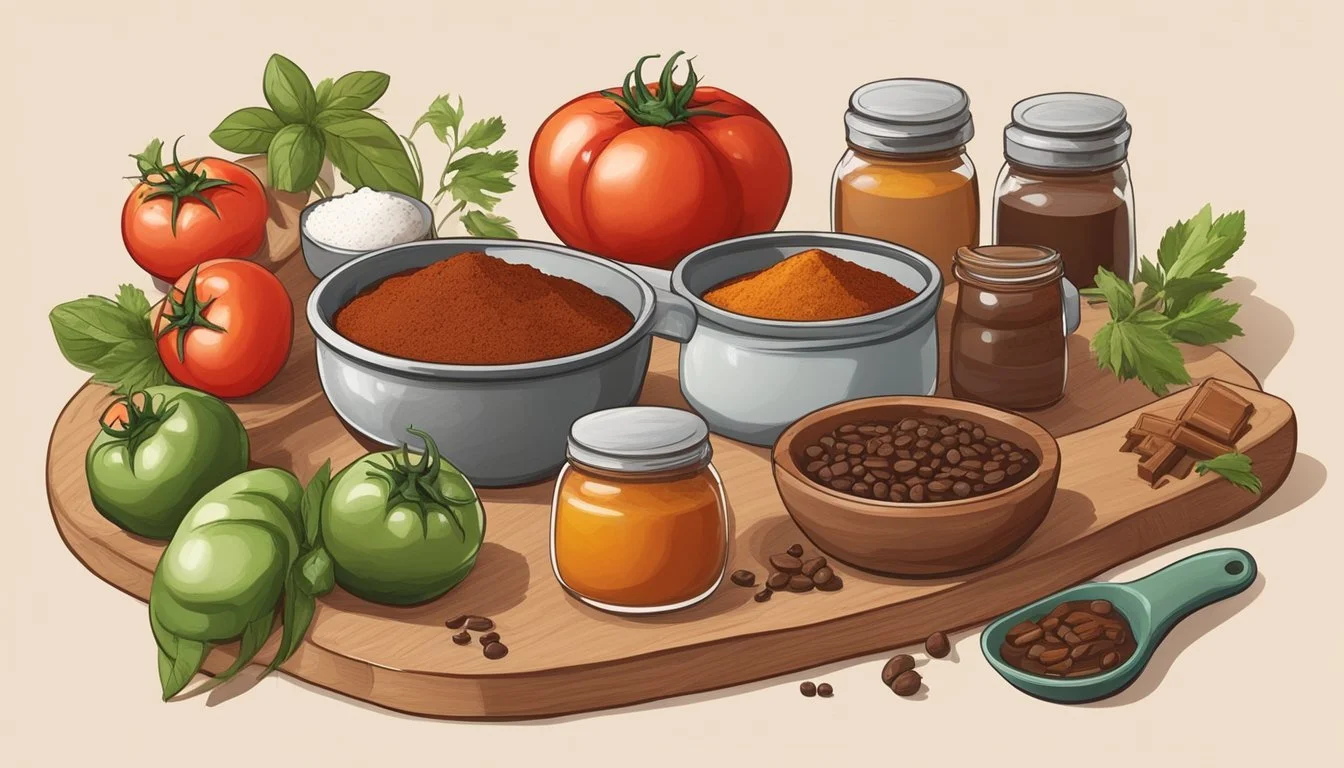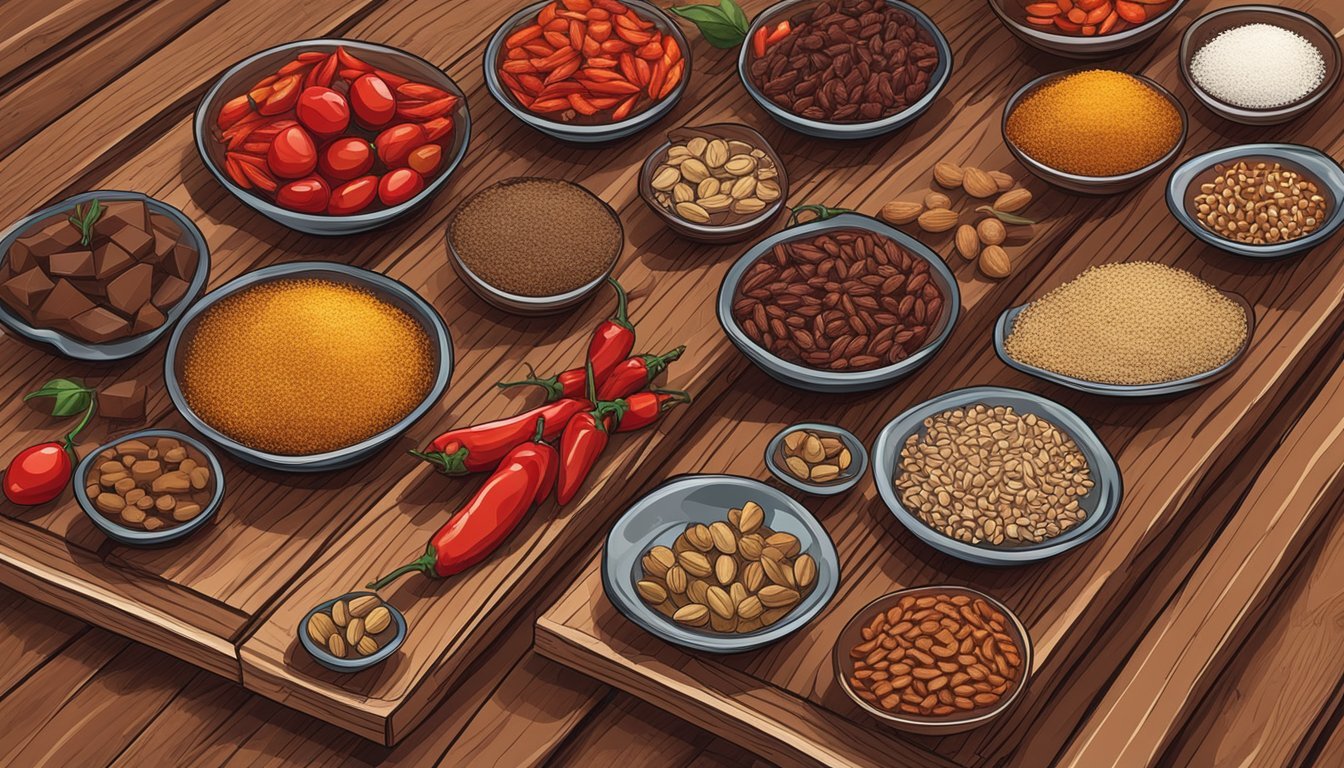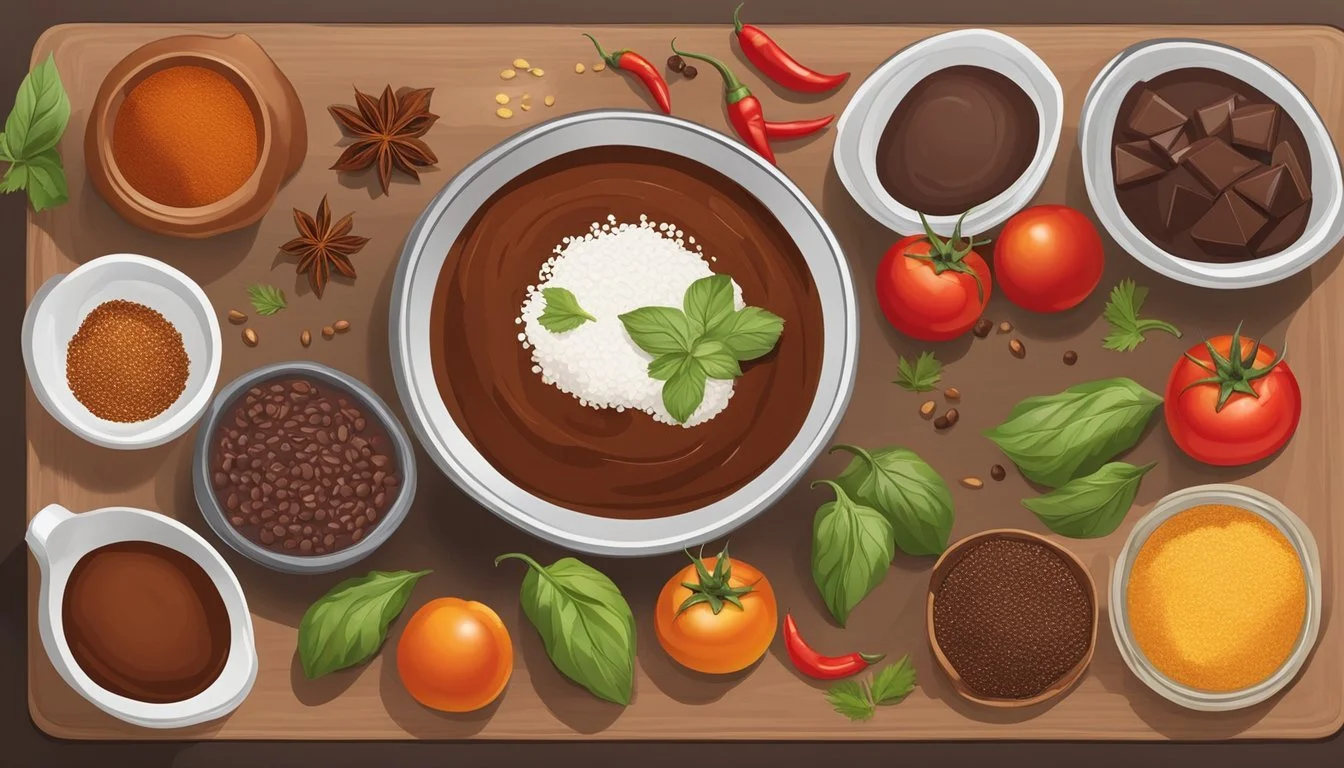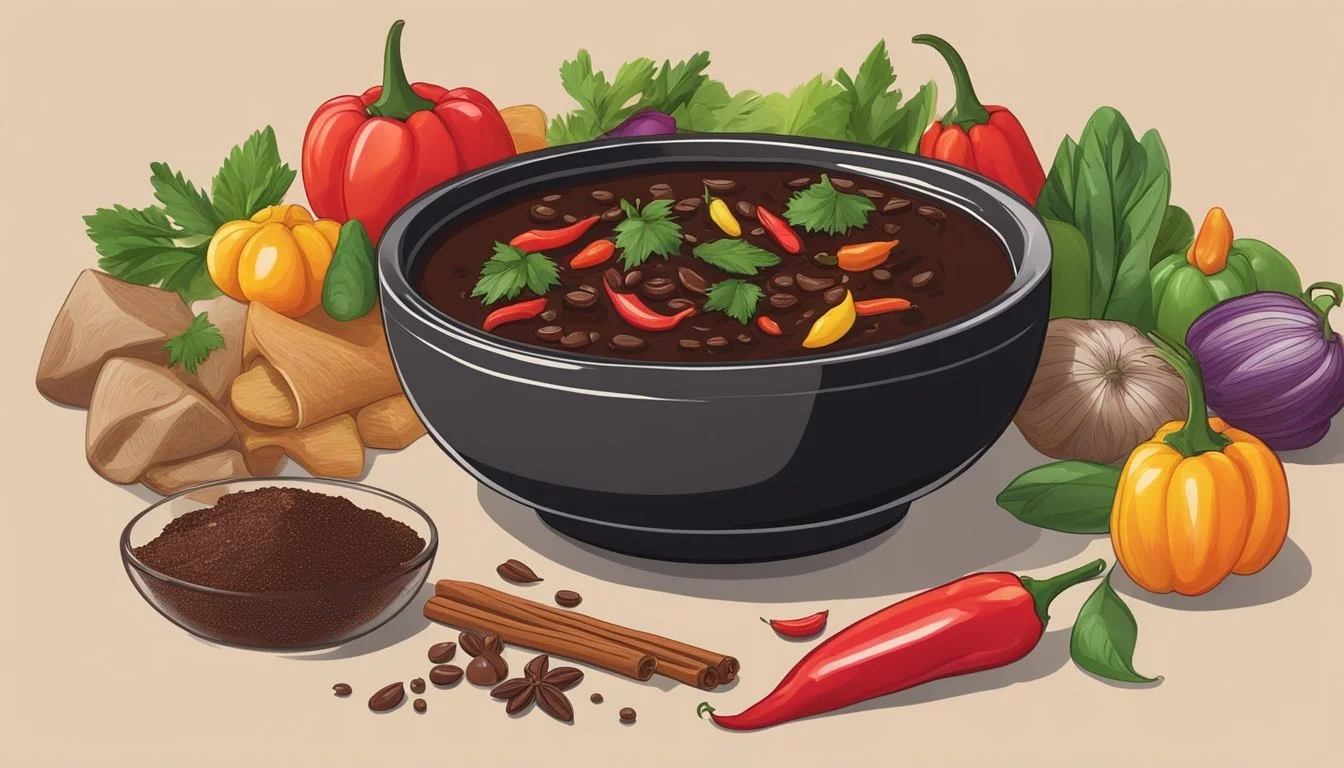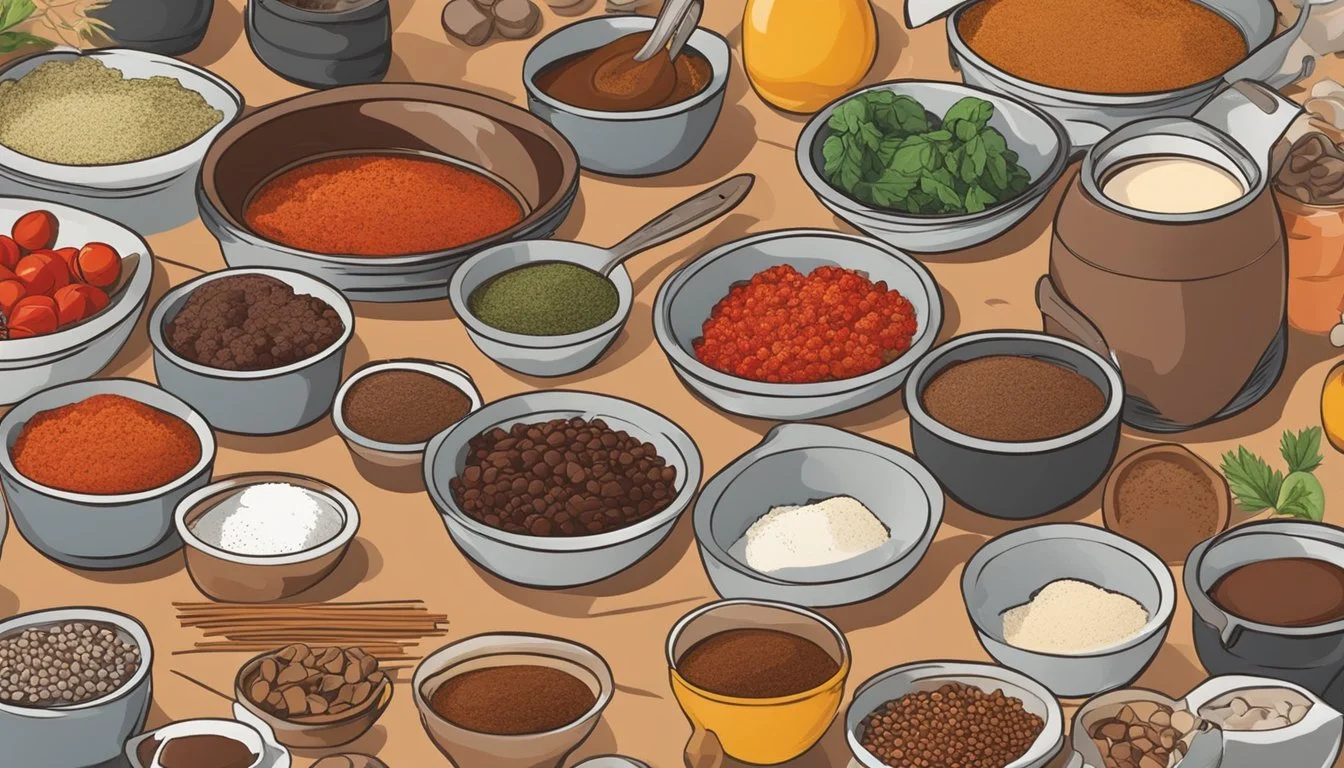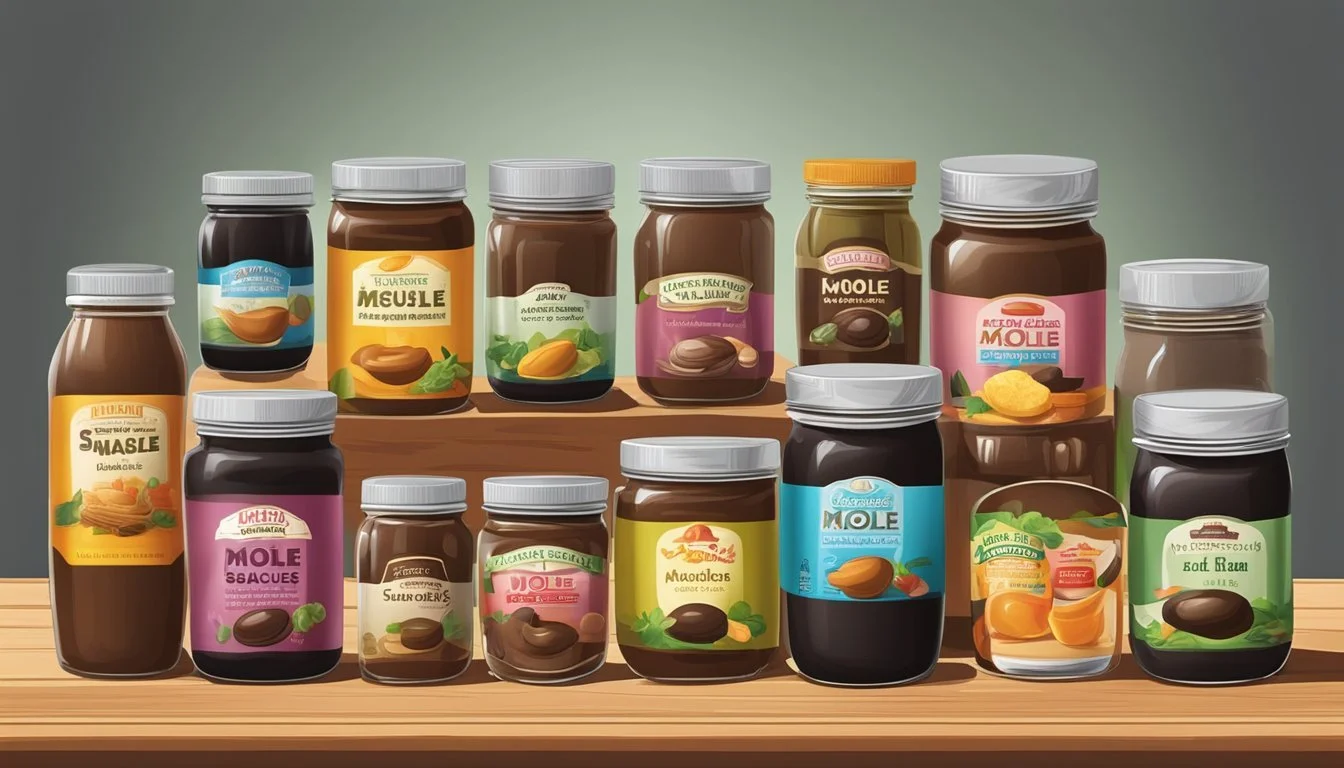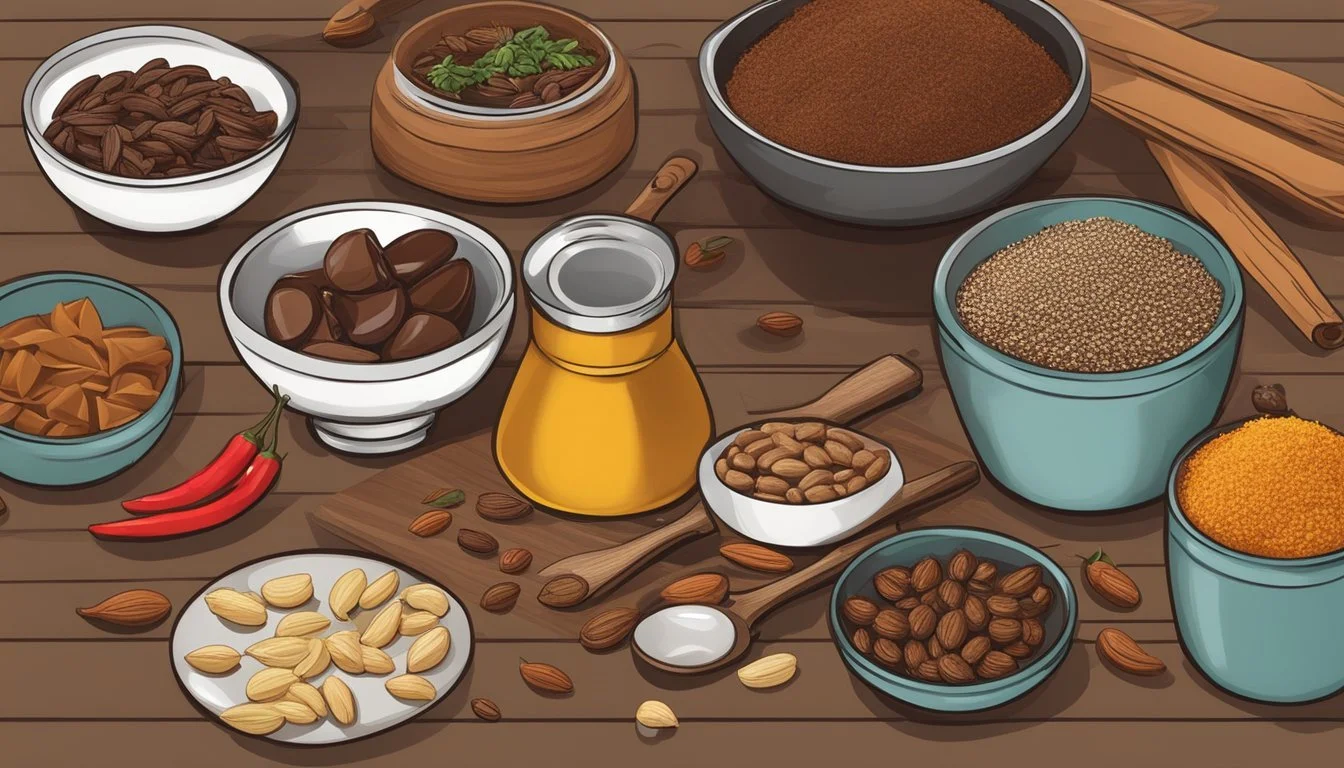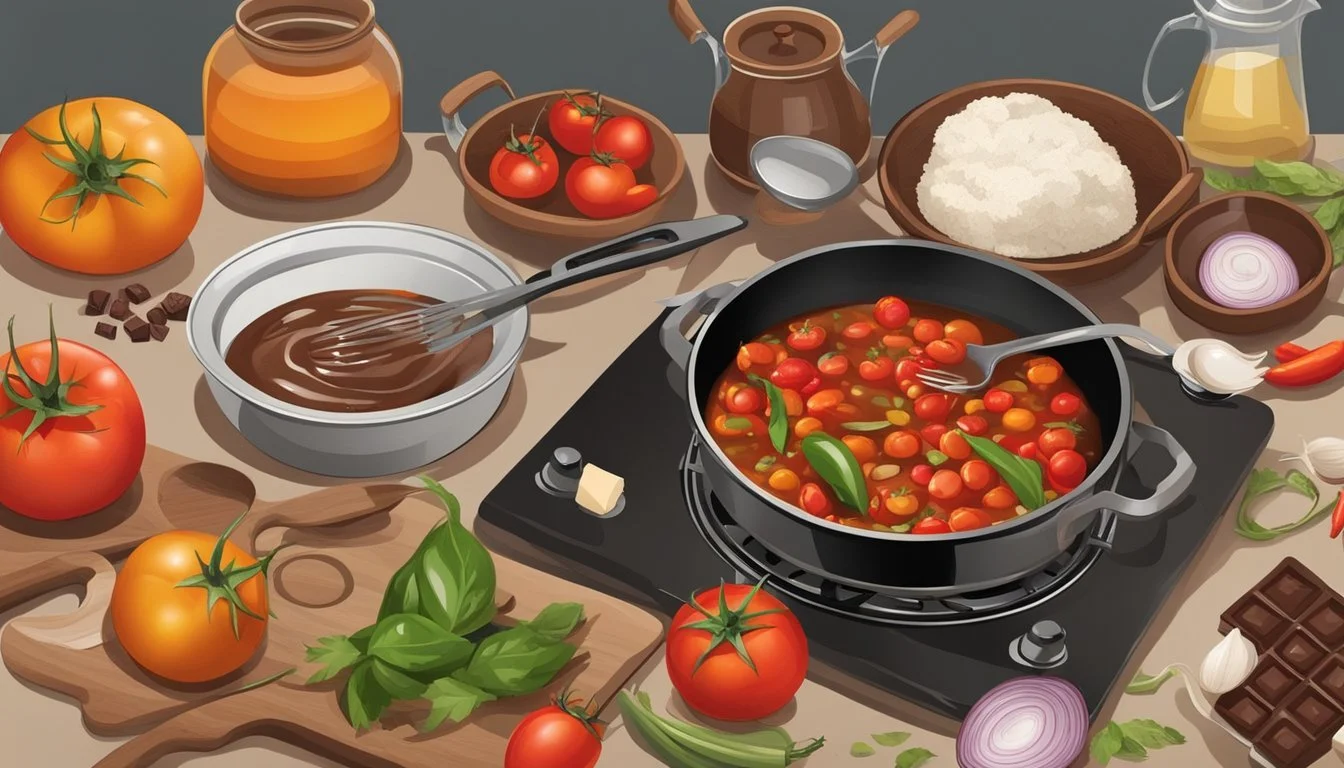Mole Sauce Substitutes
Top Alternatives for Traditional Mexican Flavors
Mole sauce, a culinary cornerstone in Mexican cuisine, is renowned for its rich flavor and intricate blend of spices and ingredients. Traditional mole recipes often require an extensive list of items such as various chiles, chocolate (What wine goes well with chocolate?), nuts, and a medley of spices, making it a complex and time-consuming sauce to prepare. However, its deep, multifaceted flavor has made it a beloved addition to dishes, particularly over meats like chicken.
Occasionally, home cooks may find themselves lacking the specific ingredients needed to create an authentic mole or may seek a quicker alternative due to time constraints. In these instances, finding suitable substitutes that capture the essence of traditional mole becomes essential. Substitutes can range from using pre-made mole pastes to blending a selection of more readily available spices and ingredients to mimic the sauce's characteristic depth and warmth.
Understanding the flavor profile of mole is key to creating a convincing substitute. It's a balance of sweet, spice, smokiness, and richness. Substitutes often leverage ingredients like peanut butter or almond butter to replace nuts, cocoa powder or a piece of dark chocolate for depth, and a combination of common spices such as chili powder, cumin, and cinnamon to achieve the warm, spicy undertones. These alternatives provide a practical solution for those looking to simplify the mole-making process while still delivering a delicious complement to a variety of dishes.
Understanding Mole Sauce
Mole sauce is a quintessence of Mexican cuisine, revered as a national dish with origins that can be traced back to the Aztecs. The word "mole" is derived from the Nahuatl word "molli," meaning sauce or concoction. This traditional Mexican sauce is best known for its intricate blend of savory and sweet flavors.
Key Components:
Chilies: Various types, both dried and fresh, create a rich depth and heat.
Spices: Ingredients such as cumin, cinnamon, and cloves add complexity.
Chocolate: Used in famous versions like Mole Poblano, providing subtle sweetness.
Nuts and Seeds: Almonds, sesame seeds, and others contribute to a thick consistency and nutty undertones.
Herbs: Elements like oregano impart aromatic layers.
Notable Varieties:
Mole Poblano: Rich, containing chocolate, it hails from Puebla.
Mole Negro: A darker, smokier version from Oaxaca.
Mole Verde: Featuring green herbs and pumpkin seeds.
Flavor Profile:
A harmonious fusion of sweet, umami, and sometimes spicy notes.
Complexity arises from carefully toasting and grinding each ingredient.
Understanding mole means appreciating its complexity and the labor-intensive preparation involved in its creation. It's an embodiment of Mexican heritage and culinary ingenuity, with each region imparting its own distinctive spin. Despite the labor, it’s a celebratory dish, often reserved for special occasions, embodying the spirit of Mexican culture in every flavorful spoonful.
Fundamental Ingredients of Mole
Mole sauce is a rich and complex concoction that plays a central role in Mexican cuisine. Its depth of flavor is achieved through a balance of carefully selected ingredients.
Primary Components:
Chocolate: Though not present in all moles, chocolate, or alternately, cocoa powder, provides a rich and subtle sweetness.
Chiles: The backbone of mole's complexity, dried chiles such as ancho, pasilla, and mulato infuse the sauce with heat and smokiness.
Spices and Seeds:
Cinnamon & Cloves: These spices add warmth and a hint of spice.
Sesame Seeds & Pumpkin Seeds: These seeds contribute texture and nuttiness.
Nuts and Dried Fruit:
Almonds & Peanuts: Ground nuts thicken the sauce and offer a creamy richness.
Raisins: They bring a natural sweetness that balances the spiciness of the chiles.
Aromatic Vegetables and Herbs:
Garlic & Onion: These aromatics form the savory base of mole.
Oregano & Cumin: Earthy oregano and fragrant cumin round out the flavor profile.
Constituents for Consistency:
Broth: Chicken stock or another type of broth is essential for achieving the desired consistency, melding all the flavors together smoothly.
Acidic Elements:
Tomatillos: A source of tanginess, giving the mole a subtle acidity.
Each ingredient plays a critical role, and while variations exist, the specified components are quintessential to mole sauce's authenticity and taste. Mole exemplifies the harmony of flavors, from sweet and spicy to earthy and savory, in one unified dish.
Popular Types of Mole
Mole sauces are integral to Mexican cuisine, each with distinct ingredients and preparations. The following are some of the most cherished varieties.
Mole Poblano
Mole Poblano is perhaps the most renowned mole, often considered the national dish of Mexico. Its dark, rich color and flavor come from a blend of dried chilies, spices, and chocolate, giving it an unmistakable earthy and slightly sweet taste.
Mole Negro
Mole Negro stands out for its deeper, almost black hue and complex flavor profile. Included among its numerous ingredients are chocolate and a particular variety of chili called chilhuacle negro, which contributes to its intense, smoky essence.
Mole Verde
Characterized by its vibrant green color, Mole Verde includes ingredients such as tomatillos, green chilies, and herbs like cilantro, delivering a fresher and herbaceous flavor that is lighter compared to its counterparts.
Coloradito
The Coloradito mole has a unique reddish-brown appearance and a slightly sweeter profile, typically utilizing ancho chili, almonds, and bananas. It's known for its versatility and slightly less intricate preparation.
Amarillo
Amarillo mole, recognizable by its yellowish color, is often made with yellow chilies and spices, resulting in a sauce that has a more subtle heat and an earthy base, often complemented by ingredients such as cumin and cloves.
Mole Sauce Health Considerations
When assessing the health aspects of mole sauce, it's essential to consider its nutritional components. Mole sauce can be relatively high in calories due to its rich ingredients such as chocolate, nuts, and sometimes even bread. These components contribute to its calorie density.
Concerning sodium, traditional recipes may call for various amounts, impacting the overall sodium content. Consuming high levels of sodium is linked to increased blood pressure, warranting moderation in consumption.
In terms of saturated fats, mole sauce can contain a moderate amount, primarily if made with traditional ingredients like lard. Saturated fats should be consumed in limited quantities as part of a balanced diet.
However, mole sauce has potential benefits owing to its fiber content, predominantly from its plant-based ingredients like chilies and nuts. Fiber is crucial for digestive health and can aid in maintaining a healthy weight.
Additionally, mole sauce includes a variety of minerals and vitamins. The chili peppers, for instance, offer vitamins A and C, and the nuts and seeds provide essential minerals like magnesium and zinc. Here is a basic nutritional profile of mole sauce:
Nutrient Consideration Calories High from nuts, chocolate Sodium Variable, can be high Saturated Fat Present from traditional fats Fiber Provided by plant ingredients Minerals Varied, beneficial presence
One should appreciate the complexity of mole sauce, embracing the health implications alongside the unique flavor it adds to dishes. Moderation is key, along with an understanding of the ingredients used in preparation, to enjoy mole sauce as part of a balanced diet.
Mole Sauce Application
Mole sauce, with its rich flavor profile, plays a versatile role in Mexican cuisine. It’s traditionally applied in dishes ranging from meats to vegetables, demonstrating its flexibility as both a main component and an enhancing condiment.
Chicken Mole
One of the most classic applications of mole sauce is Chicken Mole (Mole Poblano). The sauce is generously simmered with cooked chicken, often garnished with sesame seeds, and served with Mexican rice on the side for a harmonious meal.
Enchiladas and Tacos
Mole sauce profoundly transforms Enchiladas and Tacos. A spoonful of mole added inside or draped over the top of enchiladas before baking imparts a deep, complex flavor. For tacos, it combines with fillings such as shredded turkey or beef, providing a savory, nuanced taste.
With Roasted Vegetables
Roasted Vegetables benefit from the sauce's robustness. Mole acts as a marinade or glaze, elevating the natural sweetness of vegetables like bell peppers and zucchini through its spice-infused character.
As a Condiment
Lastly, mole sauce excels as a condiment. It can be creatively served with refried beans, used as a dip for guacamole, or even as a distinct, unexpected side to accompany roasted vegetables. Its application does not end with traditional dishes; it's a sauce that brings a touch of Mexican heritage to a wide array of foods.
Homemade Mole Sauce Variants
Crafting a mole sauce at home allows for customization to personal taste and available ingredients. Below are variants that capture the spirit of traditional mole while offering flexibility for home cooks.
Simple Mole Sauce Recipe
A pared-down mole sauce recipe still delivers rich flavor but is less demanding in terms of ingredients and preparation. One begins by sautéing onions and garlic in a skillet, then stirring in chili powder, alongside a bit of flour to build a roux. This provides a base to which one can add chicken broth, allowing the sauce to thicken. Mole's signature chocolate is introduced near the end, melting into the sauce for a characteristic depth of flavor. Often, a blender is employed to achieve a smooth consistency, followed by the use of a strainer to ensure a silky texture.
Ingredients:
1 tablespoon oil
1 onion, finely chopped
2 cloves garlic, minced
2 tablespoons chili powder
1 tablespoon all-purpose flour
2 cups chicken broth
1 ounce dark chocolate
Method:
Heat oil and cook onions and garlic.
Stir in chili powder and flour to form roux.
Slowly incorporate chicken broth.
Add chocolate; blend and strain.
Using Alternative Nuts and Seeds
Traditionally, mole sauce includes ingredients such as almonds or sesame seeds. However, one can substitute these with other nuts like pecans or seeds such as pumpkin seeds to achieve a similar rich and nuanced flavor profile. It is important to toast these alternatives lightly before blending them into the sauce, as this step enhances their flavor and contributes to the overall complexity of the mole.
Substitution options:
Pecans
Pumpkin seeds
Sunflower seeds
How to Thicken Without Traditional Ingredients
In the absence of traditional thickeners like bread or tortillas, home cooks can opt for alternatives such as ground oats or even a cornstarch slurry to provide the desired consistency in their mole sauce. These ingredients should be added cautiously and incrementally while the sauce simmers to prevent it from becoming too thick or altering the flavor profile significantly.
Thickening alternatives:
Ground oats
Cornstarch slurry
Each variant of mole sauce aims to balance complex flavors, using a diverse array of ingredients that may already be in the pantry. Whether through substitution or simplifying recipes, homemade mole sauce can be a manageable and rewarding endeavor.
Store-Bought Mole Sauce Alternatives
When searching for store-bought mole sauce alternatives, consumers have several options that can closely mimic the complex flavor profile of traditional mole. Mole sauce is known for its intricate blend of chili peppers, spices, nuts, fruit, and occasionally chocolate. The taste is layered, simultaneously offering sweetness, spice, and umami depth.
Pre-Made Mole Options
They may choose pre-made sauces that are often labeled as "Mexican sauce" or explicitly as "mole". These are readily available in the international aisle of many supermarkets. Pre-made versions provide an easy mole sauce solution without investing in the numerous individual ingredients required for homemade mole sauce.
Enchilada Sauce
A common and readily available substitute is enchilada sauce. It does not replicate the complexity of mole but offers a mild approximation that is tangy and tomato-based.
Salsa or Chili Powders
Alternatively, a salsa with a rich and deep flavor can serve as a placeholder. Shoppers might also create a swift simulacrum by mixing chili powder with cocoa powder, and nut butter, emulating the essential components of mole.
Substitute Flavor Profile Preparation Ease Pre-Made Mole Most Authentic Very Easy Enchilada Sauce Mild, Tomato-based Very Easy Salsa Variable Very Easy Chili & Cocoa Mix Customizable Moderate
Purchasers should note that while these alternatives might serve well in a pinch, each has its distinct taste and may not provide the full depth of a traditional mole sauce. It is recommended to sample small portions to ensure the substitute aligns with one's flavor preferences.
Creative Substitutes for Mole Ingredients
Crafting an authentic mole flavor often involves a complex blend of ingredients, but there are creative alternatives that can be utilized for key components in the recipe, such as chocolate, nuts, and spices, to accommodate availability or dietary preferences.
Chocolate Alternatives
Chocolate lends a rich and slightly sweet profile to mole. Instead of traditional Mexican chocolate, one could opt for:
Cocoa powder: A tablespoon can replace a typical square of chocolate.
Carob powder: Offers a sweeter profile and can be used in equal measure to cocoa.
Nut and Seed Replacements
Nuts and seeds are crucial for mole's texture and flavor. They can be replaced with:
Sunflower seeds: An allergy-friendly option, mimicking the texture of nuts.
Tahini (sesame seed paste): It can stand in for sesame seeds to retain the nutty essence.
Almond butter: This can substitute whole almonds or other nut bases in mole.
Here's a quick reference table for nut and seed substitutions:
Original Ingredient Substitute Ratio Sesame seeds Tahini 1:1 by volume Pumpkin seeds Sunflower seeds 1:1 by weight Almonds Almond butter 1 tbsp butter per 1/4 cup nuts
Spice and Seasoning Mixes
The deep flavor profile of mole comes from a blend of various spices. Key replacements include:
Ground cinnamon for sticks: The ground spice should be used sparingly, as it is more concentrated.
Chili powder or chipotle powder: These can serve as substitutes for dried ancho chiles, with adjustments for heat.
Ground coriander seeds: Aromatic and slightly citrusy, it can replace other warm spices when unavailable.
Pairing Mole Sauce with Other Cuisines
Mole sauce, a hallmark of Puebla and Oaxaca regions in Mexico, is a complex blend of spices, chilies, and often Mexican chocolate, boasting a rich depth of flavor. While it is inherently Mexican, contemporary chefs and culinary enthusiasts have successfully paired it with various cuisines.
Asian Fusion Asian dishes often use rice and similar spices which complement the robust profile of mole. Mole sauce can be introduced to stir-fries or as a glaze for Asian-style burritos, using tortillas in place of traditional bao buns.
Italian Integration In Italian cuisine, replacing traditional tomato sauces with mole on dishes like enchiladas adds a rich and spiced twist. Mole could also enhance the flavor of eggplant parmigiana, providing a sweet and spicy undertone.
American Comfort Food American staples such as burgers and hot dogs can be transformed with a mole topping, introducing a novel flavor profile. Tortilla chips and nachos gain new life when paired with a mole-inspired dip, bridging the gap between comfort food and Mexican gastronomy.
Breakfast Innovations Starting the day with mole offers a hearty and flavorful experience. Drizzling mole sauce over fried eggs or incorporating it into avocado on toast is an emerging trend. Tamales, a traditional Mexican breakfast item, can also be laced with mole for a satisfying morning treat.
Below is a table summarizing the potential pairings:
Cuisine Dish Mole Pairing Asian Fusion Stir-fry, Asian-style burritos Use mole as a complementing sauce or glaze Italian Eggplant parmigiana, Enchiladas Substitute tomato sauces with mole American Burgers, Hot dogs, Nachos Top with mole or create mole-based dips Breakfast Fried eggs, Avocado toast, Tamales Drizzle or incorporate mole into the dish
Note: While exploring these combinations, one should be mindful of the mole's intensity and ensure it harmonizes with the other ingredients to maintain a culinary balance.
Culinary Inspirations and History
Mole sauce, often considered a national dish in Mexico, has a storied past deeply rooted in the culinary traditions of Puebla and Oaxaca. It represents a fusion of indigenous and colonial influences, which can be traced back to the Aztecs and the Spanish conquest. This rich sauce carries centuries of history, embodying the complexity of Mexican cuisine.
The origins of mole are often told through colorful legends. One such tale involves nuns from Puebla hastily preparing a sumptuous dish for an unexpected visit from an archbishop. They blended the limited ingredients they had, including chili peppers, spices, and chocolate, to create the first molé sauce.
Location Contribution Puebla Birthplace of mole Oaxaca Varieties of mole
Mole's significance in Mexican culture extends beyond its ingredients. It symbolizes the intricate blend of skills and traditions passed down through generations. The sauce's preparation is a laborious process, requiring precise toasting, grinding, and simmering of numerous components.
Key Ingredients: Chili peppers, chocolate, nuts, spices
Cultural Significance: A symbol of Mexico's blended heritage
In the panorama of Mexican cuisine, mole stands out for its complex preparation and deep roots in cultural history, reflecting a legacy of culinary ingenuity and adaptability.
Conclusion
When seeking alternatives for mole sauce, culinary enthusiasts have a wide spectrum of substitutes to consider. Each substitute serves to deliver a distinctive flavor and texture, complementing the dish in its own way.
Pasilla Chile Pepper: Known for its mild to medium heat, it is a fitting poblano substitute with a unique taste profile.
Almond and Sesame Seed Mixture: Toasting nuts and seeds before blending can mimic mole's complexity.
Chocolate: A hint of chocolate can enrich a sauce, offering a subtle depth reminiscent of traditional mole.
Enthusiasts should remember that a mole's essence lies in its layered flavors. A well-crafted mole substitute brings together various spices, seeds, and chiles to achieve a balanced and savory sauce. The sauce's consistency may be modified with a thickening agent like masa or corn flour, or thinned with stocks for a lighter texture.
Through experimentation, cooks may discover combinations that suit their individual taste preferences while honoring the spirit of mole sauce. Whether used in enchiladas, with eggs, or as a tamale sauce, these substitutes ensure the continuity of mole's celebrated role in culinary tradition.

